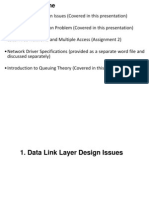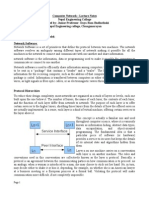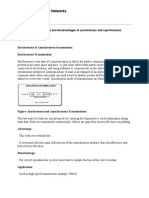The Layers of The OSI Model
The Layers of The OSI Model
Uploaded by
James HammondCopyright:
Available Formats
The Layers of The OSI Model
The Layers of The OSI Model
Uploaded by
James HammondOriginal Description:
Original Title
Copyright
Available Formats
Share this document
Did you find this document useful?
Is this content inappropriate?
Copyright:
Available Formats
The Layers of The OSI Model
The Layers of The OSI Model
Uploaded by
James HammondCopyright:
Available Formats
The layers of the OSI Model 2.3.
1 Physical Layer Physical Layer function in the delivery of raw bits into the communication channel . Design issues that must be considered here is to make sure that when one side sends a 1 bit of data , the data must be received by the other side as a 1 bit anyway , and instead of 0 bits . he !uestion that arises in this case is " how many volts that need to be used to declare the value of 1 # and how many volts are also needed for the number 0 # . $ow many microseconds re!uired a bit will run out # %s the transmission can be &rocessed simultaneously in both directions # $ow many &ins are owned utility networks and what each &in # %n general, the design &roblems that are found here related mechanical , electrical and &rocedural interfaces , and &hysical media that are under the &hysical layer. 2.3.2 Data Link Layer he main task of the data link layer is to facilitate the transmission of raw data and transform that data into the channel error'free transmission . (efore &assing kenetwork layer , data link layer this task by allowing the sender memecag broke the in&ut data into a &lurality of data frames ) ty&ically number in the hundreds or thousands of bytes * . hen the data link layer transmits the frames se!uentially , and &rocess the acknowledgment frames sent back by the receiver . (ecause of the &hysical layer receives and sends a stream of bits without regard to the meaning or architectural frame , then de&ending on the data link layer the one to make and recogni+ing the limits of the frame . his can be done by affi,ing a s&ecial bit to the beginning and end of the frame . -hen incidental bit &atterns can be found in the data , it would re!uire s&ecial attention to ensure that the &attern is not regarded as one of the boundaries of the frame . he occurrence of noise on the line can damage the frame . %n this case , the data link layer software on the source machine to send back the damaged frames . $owever, transmission of the same frames over and over again can lead to du&lication of frames . Du&licate frames need to be sent when the acknowledgment frame from the receiver is returned to the sender has been lost . De&ending on this layer to address the &roblems that caused the destruction , loss and du&lication of frames . he data link layer &rovides several classes of services for the network layer . his service class can be differentiated in terms of !uality and &rice . .ther issues that arise at the data link layer ) and also most of the layers above it * is to try the smooth &rocess of data transmission from the sender to the receiver that !uickly slow . /echanism of regulation of traffic data should allow the sender to know the amount of buffer s&ace that is owned by the reci&ient at any given moment . .ften setting the flow and error handling in an integrated manner . 0hannel that can send data in both direction can also cause &roblems . hus need to be considered for the data link layer software . he &roblem that can arise here is that acknoeledgement frames flowing from 1 to ( to com&ete with each other &recede flow from ( to 1. 0om&letion of the best ) &iggy backing * could have been used 2 later we will discuss it in de&th . (roadcast networks have an additional issue in the data link layer . he &roblem is in terms of controlling access to the shared channel . 0an be used to overcome s&ecific sublayer of data link layer , which is called the medium access sublayer .
You might also like
- Design Pickle GD Test PreparationDocument11 pagesDesign Pickle GD Test PreparationGali Casas100% (1)
- Alien IsolationDocument187 pagesAlien IsolationHandriToarPangkerego100% (1)
- Without This Message by Purchasing Novapdf : Print To PDFDocument69 pagesWithout This Message by Purchasing Novapdf : Print To PDFvalvemayamNo ratings yet
- Data Communications and NetworkingDocument3 pagesData Communications and NetworkingEaswara ElayarajaNo ratings yet
- Part 3Document26 pagesPart 3shruthi chithuNo ratings yet
- DCCN Unit-2Document31 pagesDCCN Unit-2suneelkluNo ratings yet
- Unit 2Document45 pagesUnit 2Anitha SakthivelNo ratings yet
- 1.4 Reference Models: Figure 1-20. The OSI Reference ModelDocument3 pages1.4 Reference Models: Figure 1-20. The OSI Reference ModelDinesh DinuNo ratings yet
- ComputerDocument56 pagesComputerskandapmwork2003No ratings yet
- Computer Networks NotesDocument6 pagesComputer Networks Notesshankar_missionNo ratings yet
- DLL ServicesDocument24 pagesDLL Servicesbossdhruva0No ratings yet
- CN Unit 2Document36 pagesCN Unit 2sivakotijagadeesh015No ratings yet
- 1-Introduction-To-Computer-Networking 3 UNITDocument106 pages1-Introduction-To-Computer-Networking 3 UNITSushma BodapatiNo ratings yet
- Networking Concepts: Visit - A Website On Big Ideas!Document8 pagesNetworking Concepts: Visit - A Website On Big Ideas!arunascarletNo ratings yet
- Data Link Layer5Document20 pagesData Link Layer5VenkatNo ratings yet
- Data Link Layer 1Document127 pagesData Link Layer 1Tirth SoniNo ratings yet
- PDF - 4 - UNIT 2 - OSI Model - BRIEFLYDocument7 pagesPDF - 4 - UNIT 2 - OSI Model - BRIEFLYfranky0918890No ratings yet
- MC0075 - Computer NetworksDocument10 pagesMC0075 - Computer NetworksManindersuriNo ratings yet
- Chapter 3Document41 pagesChapter 3Solomon W. DemissieNo ratings yet
- S Osi ModelDocument4 pagesS Osi ModelkrishnaguptamdzNo ratings yet
- 2 Unit-2Document33 pages2 Unit-2it.mohanNo ratings yet
- CN Experiment 2Document6 pagesCN Experiment 2rudraNo ratings yet
- Chapter 3Document9 pagesChapter 3shashankniecNo ratings yet
- Osi & Rs232Document8 pagesOsi & Rs232dklikeNo ratings yet
- Assignment-1: Internet & Multimedia TechnologyDocument6 pagesAssignment-1: Internet & Multimedia TechnologySwarnim ShuklaNo ratings yet
- Tnlearners and Webexpo: Unit I Frame Relay NetworksDocument104 pagesTnlearners and Webexpo: Unit I Frame Relay Networksrsrinisha215No ratings yet
- Module-4-TransportLayerDocument81 pagesModule-4-TransportLayerSafa HamzaNo ratings yet
- Network Models: Solutions To Review Questions and ExercisesDocument4 pagesNetwork Models: Solutions To Review Questions and ExercisesRitika JainNo ratings yet
- MC0075 Sem3 Smu 2011Document31 pagesMC0075 Sem3 Smu 2011Nitin SivachNo ratings yet
- Unit Ii: Design Issues in Data Link Layer: Error Detection and Correction: ApplicationsDocument125 pagesUnit Ii: Design Issues in Data Link Layer: Error Detection and Correction: ApplicationsNAMAN JAISWALNo ratings yet
- DLL Sept22 23Document5 pagesDLL Sept22 23Roshan RaviNo ratings yet
- Lec 15Document37 pagesLec 15Shailza SinghNo ratings yet
- CN_CDT10Document31 pagesCN_CDT10SHABAZUDDIN MOHAMMEDNo ratings yet
- CN 2Document302 pagesCN 2Ankur AhireNo ratings yet
- Unit 2Document15 pagesUnit 2Rishan KundetyNo ratings yet
- Networking ConceptsDocument8 pagesNetworking Conceptshbgfjghjj hhfhNo ratings yet
- MC0075 - Winter Drive Assignment-2011Document35 pagesMC0075 - Winter Drive Assignment-2011Mannish KumarNo ratings yet
- Chapter 5Document24 pagesChapter 5shashankniecNo ratings yet
- CN Notes Unit 2 PKDocument23 pagesCN Notes Unit 2 PKlalits7420No ratings yet
- Data Link Layer - Computer NetworksDocument102 pagesData Link Layer - Computer NetworksShivasai NampellyNo ratings yet
- Cs 2363 Computer Networks: Part A Questions With Answers & Part B QuestionsDocument14 pagesCs 2363 Computer Networks: Part A Questions With Answers & Part B QuestionsMaheswariKirubakaranNo ratings yet
- Computer Networking Unit-2Document64 pagesComputer Networking Unit-2NaniNo ratings yet
- Unit_1Document14 pagesUnit_1Laxman RaoNo ratings yet
- G Unit-IiDocument135 pagesG Unit-Iihemanthkumarnani0No ratings yet
- Data Communications and Networking 2Document8 pagesData Communications and Networking 2Jesse De LeonNo ratings yet
- CNS Unit-2 (Part-1) by Pooja HandeDocument156 pagesCNS Unit-2 (Part-1) by Pooja Handeshaktimohan091No ratings yet
- Chapter IV Data Link LayerDocument39 pagesChapter IV Data Link LayerSheba ParimalaNo ratings yet
- NetworkDocument67 pagesNetworkBiplov SapkotaNo ratings yet
- Data Link Layer (2)Document9 pagesData Link Layer (2)Kiran GuptaNo ratings yet
- Data Link LayerDocument30 pagesData Link LayerchipoNo ratings yet
- 403 CombinedDocument7 pages403 CombinedMayowa AdegbuyiNo ratings yet
- Chapter 3Document148 pagesChapter 3Pratham SuhasiaNo ratings yet
- Computer NetworksDocument176 pagesComputer Networksnetra14520No ratings yet
- Computer Networks: 1.2 Network HardwareDocument58 pagesComputer Networks: 1.2 Network HardwareSai KrishNo ratings yet
- CN UNIT-2 NotesDocument70 pagesCN UNIT-2 NotesYeshwanth KrishnaNo ratings yet
- List The Layers of The Internet ModelDocument4 pagesList The Layers of The Internet ModelBombo Rasta60% (5)
- UNIT-2 Computer Networks - 1Document14 pagesUNIT-2 Computer Networks - 1danaboinamadhavi234No ratings yet
- Error Detection, Correction and Wireless CommunicationDocument75 pagesError Detection, Correction and Wireless CommunicationManofwarriorNo ratings yet
- Physical_LayerDocument54 pagesPhysical_LayerkrpiyushpandeyNo ratings yet
- CS2060 High Speed Networks Lecture Notes Unit I To VDocument94 pagesCS2060 High Speed Networks Lecture Notes Unit I To VkanjaiNo ratings yet
- Billing Rate InkindoDocument3 pagesBilling Rate InkindoJames Hammond100% (1)
- Introdction. Haier: Taking A Chinese Company GlobalDocument1 pageIntrodction. Haier: Taking A Chinese Company GlobalJames HammondNo ratings yet
- Company PresentationDocument3 pagesCompany PresentationJames HammondNo ratings yet
- The Importance of Human Capital in The Era of GlobalizationDocument1 pageThe Importance of Human Capital in The Era of GlobalizationJames HammondNo ratings yet
- Toyota To FordDocument3 pagesToyota To FordJames HammondNo ratings yet
- 3D Modelling in Computer Aided DesignDocument6 pages3D Modelling in Computer Aided DesignpsranaweNo ratings yet
- Positioning CourseDocument230 pagesPositioning CoursesakuNo ratings yet
- C Program To Delete All Nodes of Singly Linked List - CodeforwinDocument1 pageC Program To Delete All Nodes of Singly Linked List - CodeforwinPratikRoyNo ratings yet
- Implementing Off Page ConnectorsDocument9 pagesImplementing Off Page ConnectorsihllhmNo ratings yet
- Survey On Segmentation and Penetration of Payzapp A Product of HDFC BankDocument5 pagesSurvey On Segmentation and Penetration of Payzapp A Product of HDFC BankAman KatiyarNo ratings yet
- Monitoring and Performance Tuning Oracle E-Business Self Service TransactionsDocument34 pagesMonitoring and Performance Tuning Oracle E-Business Self Service TransactionsChristian ValenciaNo ratings yet
- UNIT 3 MechatronicsDocument38 pagesUNIT 3 MechatronicsMuthuvel M67% (6)
- Fun With FormulasDocument13 pagesFun With FormulasHaseeb Ullah KhanNo ratings yet
- Adv Control & Robotic Lec 1aDocument9 pagesAdv Control & Robotic Lec 1akey3hseNo ratings yet
- Load Generator and Combination For RAM STRUCTURAL SYSTEMDocument28 pagesLoad Generator and Combination For RAM STRUCTURAL SYSTEMWilbert ReuyanNo ratings yet
- Git and Github IntroDocument16 pagesGit and Github IntroVarun JayaramaNo ratings yet
- 18cs43 Os Module1Document46 pages18cs43 Os Module1Shan MpNo ratings yet
- Mini Project Report On Currency ConverterDocument17 pagesMini Project Report On Currency Converterbrunodash1455No ratings yet
- Asa General CliDocument996 pagesAsa General CligladiadorcitoNo ratings yet
- La Consolacion University Philippines: Valenzuela St. Capitol View Park Subd., Bulihan, City of MalolosDocument1 pageLa Consolacion University Philippines: Valenzuela St. Capitol View Park Subd., Bulihan, City of MalolosReena BoliverNo ratings yet
- Mips Instruction FormatDocument41 pagesMips Instruction Formatvivek patelNo ratings yet
- DP 12 1 SGDocument36 pagesDP 12 1 SGreginayasminnNo ratings yet
- ag-METTLER TOLEODocument84 pagesag-METTLER TOLEOMohammed S.GoudaNo ratings yet
- 1 - Introduction To PythonDocument52 pages1 - Introduction To PythonHERiTAGE1981No ratings yet
- Quick Reference SAP CRM Version2.0Document16 pagesQuick Reference SAP CRM Version2.0shendesandeepNo ratings yet
- F 0551 Amevision For 3050Document2 pagesF 0551 Amevision For 3050Kevin PratyatamaNo ratings yet
- SAP HANA Modeling Guide XSDocument226 pagesSAP HANA Modeling Guide XSWagBezerraNo ratings yet
- RFP Vulnerability Assesstment & Penetration TestDocument6 pagesRFP Vulnerability Assesstment & Penetration TestsrimadhavaNo ratings yet
- Ritmurile LuniiDocument161 pagesRitmurile Luniimonicav2008No ratings yet
- BA EnCal 3000 Controller enDocument118 pagesBA EnCal 3000 Controller enDucVikingNo ratings yet
- Evolutionary Digital Twin A New Approach For Intelligent Industrial Product DevelopmentDocument16 pagesEvolutionary Digital Twin A New Approach For Intelligent Industrial Product DevelopmentDavidSuNo ratings yet
- Eblocks2 DatasheetDocument82 pagesEblocks2 DatasheetAbel Alejandro Castro M.No ratings yet






























































































